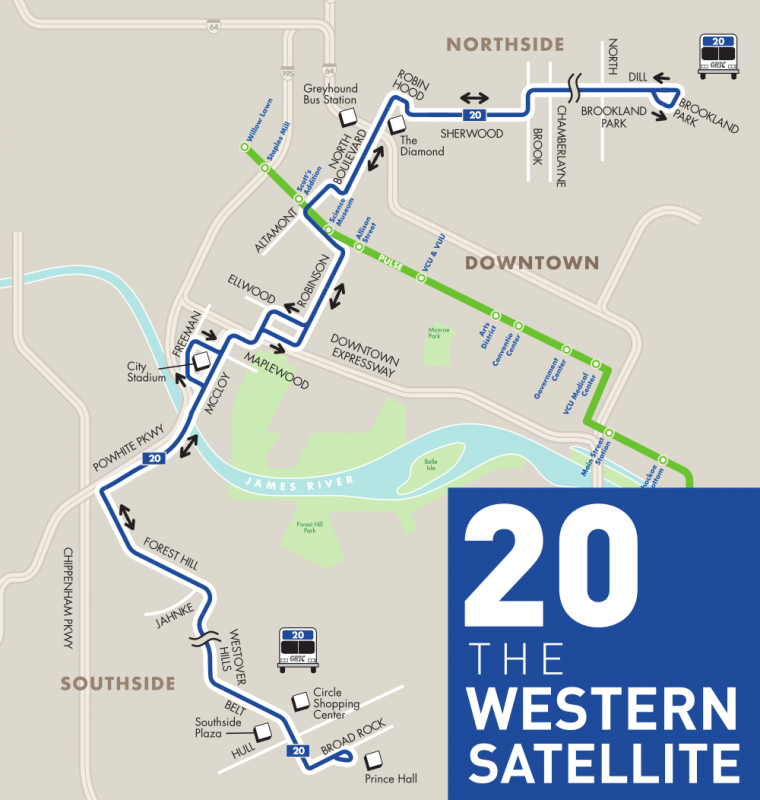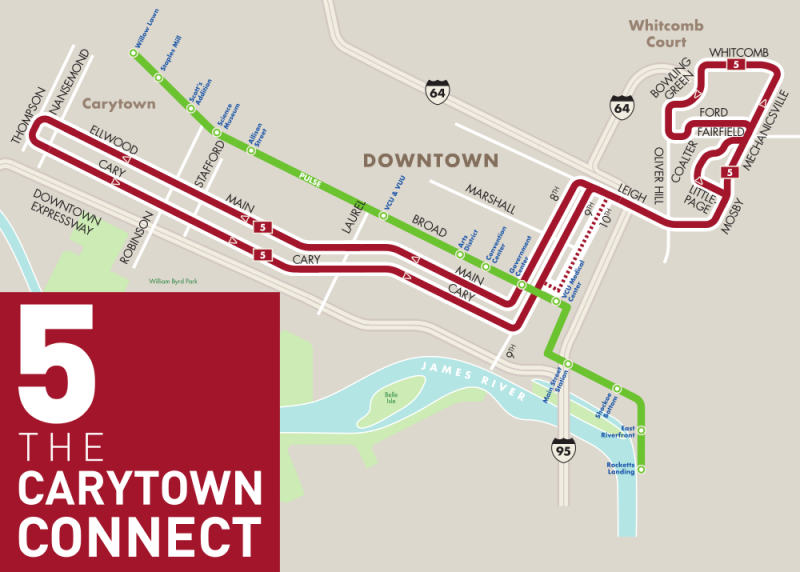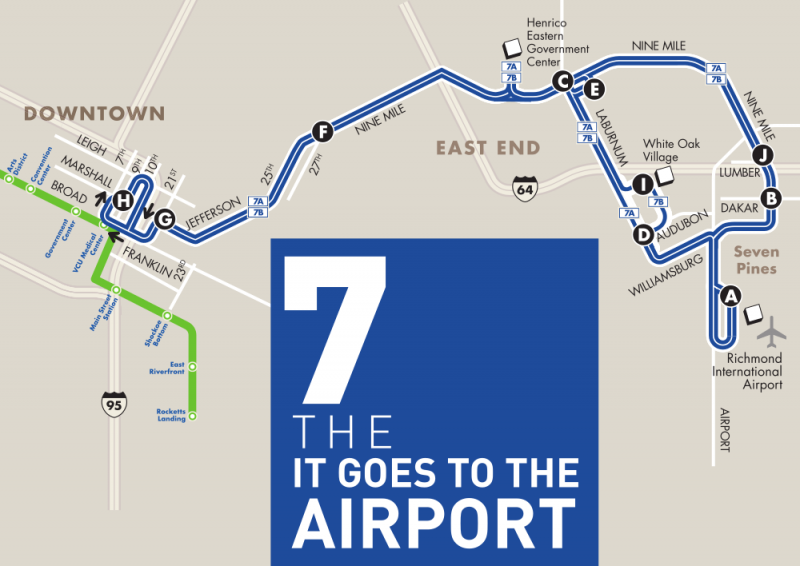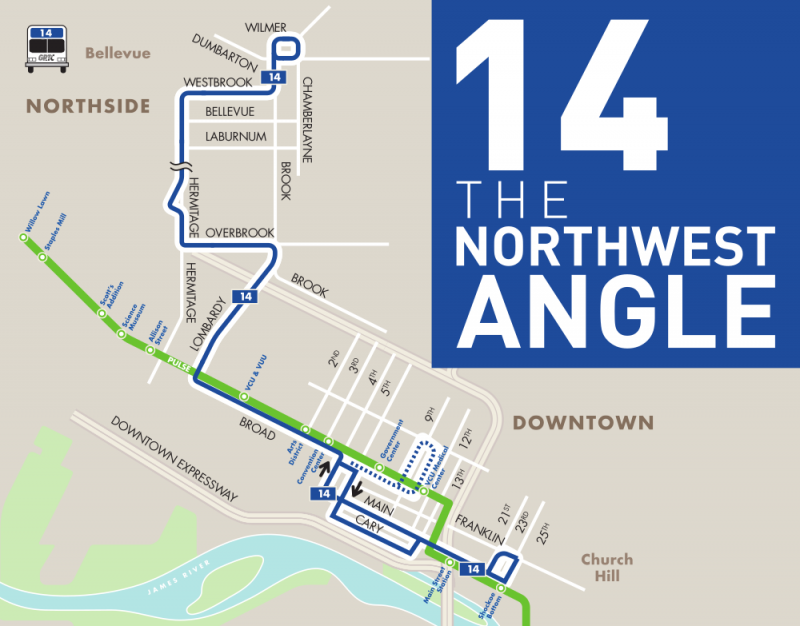Beyond the Pulse: Six Majorly New and Improved GRTC Connections

While Richmond’s attention has been focused raptly this week on the new GRTC Pulse BRT service, which is a great new addition to the city’s transit network, what’s gotten somewhat less attention despite reaching into every corner of the City of Richmond is the complete overhaul of the local route network.
Through the Richmond Transit Network Plan process started in April of 2016, GRTC along with professional consultants and neighborhood groups took a long look at a network that had been, despite decades of significant change in the city, largely untouched and unaltered.
Here are just six of the many local routes that are either brand new or substantially upgraded from previous incarnations to provide better transit service to more people and places within the City of Richmond.
I’ve given them nicknames, because why not, but the official names are noted first!
#20 Orbital: The Western Satellite

- Route: Southside to Northside via Carytown & Boulevard
- Catch it on: Broad Rock, Belt, Westover Hills, Forest Hill, McCloy, Maplewood/Ellwood, Robinson, Altamont, N Boulevard, Sherwood, Brookland Park
- Frequency: Every 30 minutes
- Connects to Pulse: Science Museum and Scott’s Addition stations
The new 20 is a brand spanking new route, and it’s a big “finally” moment: with the 20, you can get between the Southside and the Northside without going downtown at all.
That’s right. Trips between the Northside or Southside and Carytown or Scott’s Addition can just make the trip directly now using the 20, and since the route intersects with lots of 15 minute services along the way, it’s a cinch to make a connection and jump onto it.
Unfortunately, it’s not as perfectly direct as it might be, since the current Nickel Bridge structure is not rated for buses so the vehicles do have to use the Powhite Bridge instead. But something to keep in mind for when its replacement comes due is making sure the next one can, yeah?
#20 Destinations
- McGuire Veterans Administration Hospital
- Southside Plaza
- Westover Hills & Forest Hill shops
- Willow Oaks
- City Stadium
- Carytown
- Western Fan
- Scott’s Addition
- Greyhound Station
- The Diamond
- Diversity Thrift
- Children’s Hospital of Richmond Brook Road
- Brookland Park shops
- Six Points
#5 Cary/Main/Whitcomb: The Carytown Connect

- Route: Carytown to Whitcomb via Downtown
- Catch it on: Main/Cary, 8th/9th, Mosby, Mechanicsville, Whitcomb, Bowling Green, Oliver Hill, Ford, Coalter
- Frequency: Every 15 minutes
- Connects to Pulse: Government Center station
This is another route where planners took a golden opportunity to merge a number of lower-utility services into what comes out to be a brand new service with excellent 15 minute frequency. GRTC in this case paired up service upgrades on the north side of the Fan and Museum District to BRT with a brand new 15 minute frequency on the south side main drags, Cary and Main. Through-routing it to the populous northwest corner of the East End makes for a very high utility transit route.
Carytown and the Main Street strip are both packed with businesses small and large – restaurants, shops, bars – and combine that with the Fan’s high residential density and added frequent connections to the south side of VCU’s Monroe Park Campus and you’ve got yourself a great new way to move around.
#5 Destinations
- Carytown restaurants & shops/Museum District
- Main Street restaurants & shops/The Fan
- VCU Monroe Park Campus
- Downtown
- VCU MCV Campus
- Mosby Court
- Whitcomb Court
#1/2/3: The Northside/Southside Stack

If you look at the list of routes, this is a dizzying nine separate routes, with each numbered route having an A, B, and C variant, but how they’ll work in practice for a lot of trips is an excellent example of a vital design feature of the new GRTC network. For the entirety of the areas highlighted in pink above – and seen, of course, in red on the overall system map – even though each of the lettered branches is somewhat lower frequency, they combine with carefully scheduled overlaps to provide 15 minute frequency.
How does this sorcery work? It’s easier to see it with an example, here’s one for the 1 southbound from Chamberlayne & Wilmer. The 1A has 30 minute frequency, and the 1B and 1C have hourly frequency. How does 30 + 60 + 60 equal 15 though? When building the schedule, planners just had to slot them together like this:
All three of these major trunk Northside to Southside via Downtown routes use this pattern to ensure that we’re directing the most service to the places with heaviest transit usage and less to places that aren’t as densely populated or heavily traveled.
We’ll look at these separately.
#1 Chamberlayne/2 North/3 Highland: The Northside Stack

- Routes:
- #1: Chamberlayne via Battery Park and Downtown to Southside (Hull)
- #2: North via Barton Heights and Downtown to Southside (Forest Hill)
- #3: 4th/Meadowbridge via Chestnut Hill and Downtown to Southside (Jeff Davis)
- Frequency: Every 15 minutes
- Connects to Pulse:
- #1: Convention Center, Government Center, VCU Medical Center stations
- #2: Convention Center, Government Center stations
- #3: Convention Center, Arts District stations
These three corridors have all had very high transit usage in the past, so obviously in redesigning the network planners made sure to include heavy-duty service along all of them. Again, don’t worry about the multiple letters: they all combine to give 15 minute frequency all day.
Unlike in the previous GRTC network though, these routes don’t just dead-end downtown. They run across downtown and continue on the south side of the James. Let’s move on and check out where they go.
#1 Hull/#2 Forest Hill/#3 Jeff Davis: The Southside Stack

- Routes:
- #1: Downtown to Southside Plaza via Mayo Bridge
- #2: Downtown to 26th & Semmes via Manchester Bridge
- #3: Downtown to Jeff Davis & Harwood via Lee Bridge
- Frequency: Every 15 minutes
- Connects to Pulse:
- #1: VCU Medical Center, Government Center, and Convention Center stations
- #2: Government Center and Convention Center stations
- #3: Arts District and Convention Center stations
Now this is really awesome. Much of the south side of the James River is rather lower density – more spread out, fewer people and businesses per square mile – than the north side. That usually points to lower frequency transit service.
This is where the letters really come into play. Each of the three routes’ A, B, and C points have a different Southside terminus and a different way of getting there. This lets GRTC extend some service even to places that don’t demand a ton. But approaching downtown, they took the opportunity to match up the schedules such that in this densest part of Southside and provide 15 minute frequency from the bridges to a natural branch point.
Neighborhoods like Spring Hill, Swansboro, Blackwell, Oak Grove, and Manchester that traditionally have had to deal with service that reached multiple destinations far beyond them but at wildly varying times and intervals now have consistent service every 15 minutes all day long to get downtown and beyond.
#7 Nine Mile Henrico: The “It Goes To The Airport”

- Route: Downtown to RIC Airport via Church Hill, White Oak
- Catch it on: 9th, 10th, Broad, Jefferson, 25th, Nine Mile, Laburnum, at RIC Upper Terminal
- Frequency: Every 30 minutes
- Connects to Pulse: VCU Medical Center and Government Center stations
As long as you’ve lived in Richmond – yes, whatever that interval personally is for you – you’ve probably heard people say they wish there was transit service to the airport. There has been already – kinda, sorta – but extremely infrequent and not at all close to where you would go to actually use an air service. But anyway.
Also as long as you’ve been asking this, if you’ve ever actually gone to the point of asking a GRTC official why it doesn’t exist already, you’ve gotten the same answer: if it’s ever going to happen, Henrico has to pay for it. Which is true. GRTC has full routing authority within the City of Richmond, but Henrico and Chesterfield have to pay for and approve service in their localities themselves.
Henrico finally stepped up to the plate on this long-standing request, and the #7 now serves the Richmond International Airport upper deck (Departures) every 30 minutes. Don’t expect to see it crammed with air travelers though, even though some will choose to use it to get out of or into town. The biggest upgrade here is for airport and concessionaire staff.
#7 Destinations
- VCU MCV Campus
- Union Hill
- Church Hill North
- Henrico East Government Center
- Laburnum & Nine Mile shops
- White Oak Village shops
- Highland Springs
- Richmond International Airport
#4 Montrose/Darbytown: The Fulton Full-On

- Route: Shockoe Bottom to Fulton
- Frequency: Every 15 minutes
- Connects to Pulse: Shockoe Bottom station (both); Rocketts Landing and East Riverfront stations (B/Williamsburg Rd only)
This dynamic duo of 4s – an A route through the newer Fulton Bottom communities up to the top of Montrose Heights and a B leg taking Williamsburg Road to the city limits at Darbytown – gives Fulton residents more frequent service than has run through the neighborhood in decades, even in the old days of the through-running 6.
#14 Hermitage/East Main: The Northwest Angle

- Route: Northside to Shockoe Bottom via Bellevue, VUU, Fan & Downtown
- Catch it on: Brook, Westbrook, Hermitage, Overbrook, Lombardy, 4th/5th, Main, Cary
- Frequency: Every 30 minutes
- Connects to Pulse: VCU/VUU, Arts District, Convention Center, Main Street Station, and Shockoe Bottom stations
Another new through-routing, the 14 is quite a workforce of a local route. It makes direct local connections from the VUU campus to the north and south, and not just to downtown, but all the way to the eastern edge of Shockoe Bottom.
#14 Destinations
- Chamberlayne & Azalea shops
- Westminster Canterbury
- MacArthur Avenue/Bellevue shops
- Hardywood Park
- VUU Campus
- Lombardy Kroger
- Downtown
- Shockoe Bottom
Hungry for More?
There’s a lot of information out there, but if you’re going to start with anything, start with looking at the map and checking out schedules.
It’s an exciting time for Richmond, and if you haven’t had a chance to try some new services over the free first week, don’t despair. An unlimited ride day pass is still just $3.50 and you can grab one at any Pulse ticket machine, CVS, via the GRTC Mobile Pass app, or just pay exact change on board any bus and explore away.